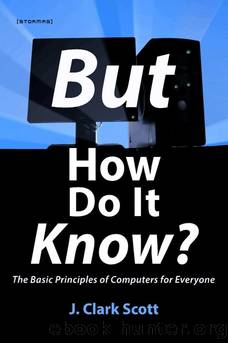But How Do It Know? - the Basic Principles of Computers for Everyone by J Clark Scott

Author:J Clark Scott [Scott, J Clark]
Language: eng
Format: epub
ISBN: 9780615303765
Amazon: 0615303765
Publisher: John C. Scott
Published: 2009-07-03T16:00:00+00:00
Below is the wiring within the Control Section that does the âfetchâ part of the instruction cycle. It uses the first three steps of the stepper and is the same for all types of instructions.
The stepperâs first three steps are shown here, and result in âfetchingâ the next âinstructionâ from RAM. Then the rest of the steps âexecuteâ the âinstruction.â Exactly what will be done in steps 4, 5 and 6, is determined by the contents of the instruction that was fetched. Then the stepper starts over, fetches the next instruction, and executes it.
The bottom of this diagram includes the Instruction Register. Notice that we have given numbers to the individual bits of the IR, 0 at the left through 7 on the right. We will be referring to the individual bits soon.
Here are the details of exactly how steps 1, 2 and 3 result in fetching an instruction in our little computer:
Step 1 is the most complicated because we actually accomplish two things at the same time. The main thing we want to do is to get the address in IAR over to MAR. This is the address of the next instruction that we want to fetch from RAM. If you look at the wire coming out of step 1 of the stepper, you can see that two of the places it is connected to are the âenableâ of IAR and the âsetâ of MAR. Thus, the contents of IAR will be placed on the bus during âclk eâ and set into MAR during âclk s.â Sometime during the instruction cycle, we need to add 1 to the value in IAR, and since IAR is already on the bus, we might as well do it now. If we donât send anything to the ALUâs âopâ bits, they will all be zero, and since 000 is the code for ADD, the ALU will be doing an ADD operation on whatever is on its two inputs, and presenting the answer to ACC. One input comes from the bus, which has IAR on it during this time. If we also turn on the âbus 1â bit during step 1, the other input to the ALU will be a byte with the binary value of 1. If we turn on the âsetâ of ACC during âclk s,â we will capture the sum of IAR plus 1 in ACC. This just happens to be the address of the instruction that we will want to fetch after we are done with the current one!
Step 2 enables the currently selected byte in RAM onto the bus, and sets it into IR. This is the instruction that we will âexecuteâ in steps 4, 5 and 6 of this instruction cycle. In the diagram, you can see that the wire coming from step 2 is connected to the âenableâ of RAM and the âsetâ of IR.
In step 3, we need to finish updating IAR. We added 1 to it in step 1, but the answer is still in ACC.
Download
This site does not store any files on its server. We only index and link to content provided by other sites. Please contact the content providers to delete copyright contents if any and email us, we'll remove relevant links or contents immediately.
Sass and Compass in Action by Wynn Netherland Nathan Weizenbaum Chris Eppstein Brandon Mathis(7915)
Grails in Action by Glen Smith Peter Ledbrook(7880)
Secrets of the JavaScript Ninja by John Resig Bear Bibeault(6631)
Kotlin in Action by Dmitry Jemerov(5295)
WordPress Plugin Development Cookbook by Yannick Lefebvre(4176)
Mastering Azure Security by Mustafa Toroman and Tom Janetscheck(3421)
Learning React: Functional Web Development with React and Redux by Banks Alex & Porcello Eve(3113)
Mastering Bitcoin: Programming the Open Blockchain by Andreas M. Antonopoulos(2947)
A Blueprint for Production-Ready Web Applications: Leverage industry best practices to create complete web apps with Python, TypeScript, and AWS by Dr. Philip Jones(2760)
The Innovators: How a Group of Hackers, Geniuses, and Geeks Created the Digital Revolution by Walter Isaacson(2670)
The Art Of Deception by Kevin Mitnick(2659)
Drugs Unlimited by Mike Power(2512)
Kali Linux - An Ethical Hacker's Cookbook: End-to-end penetration testing solutions by Sharma Himanshu(2337)
Writing for the Web: Creating Compelling Web Content Using Words, Pictures and Sound (Eva Spring's Library) by Lynda Felder(2291)
Hands-On Cybersecurity with Blockchain by Rajneesh Gupta(2277)
SEO 2018: Learn search engine optimization with smart internet marketing strategies by Adam Clarke(2213)
JavaScript by Example by S Dani Akash(2168)
DarkMarket by Misha Glenny(2120)
Wireless Hacking 101 by Karina Astudillo(2109)
